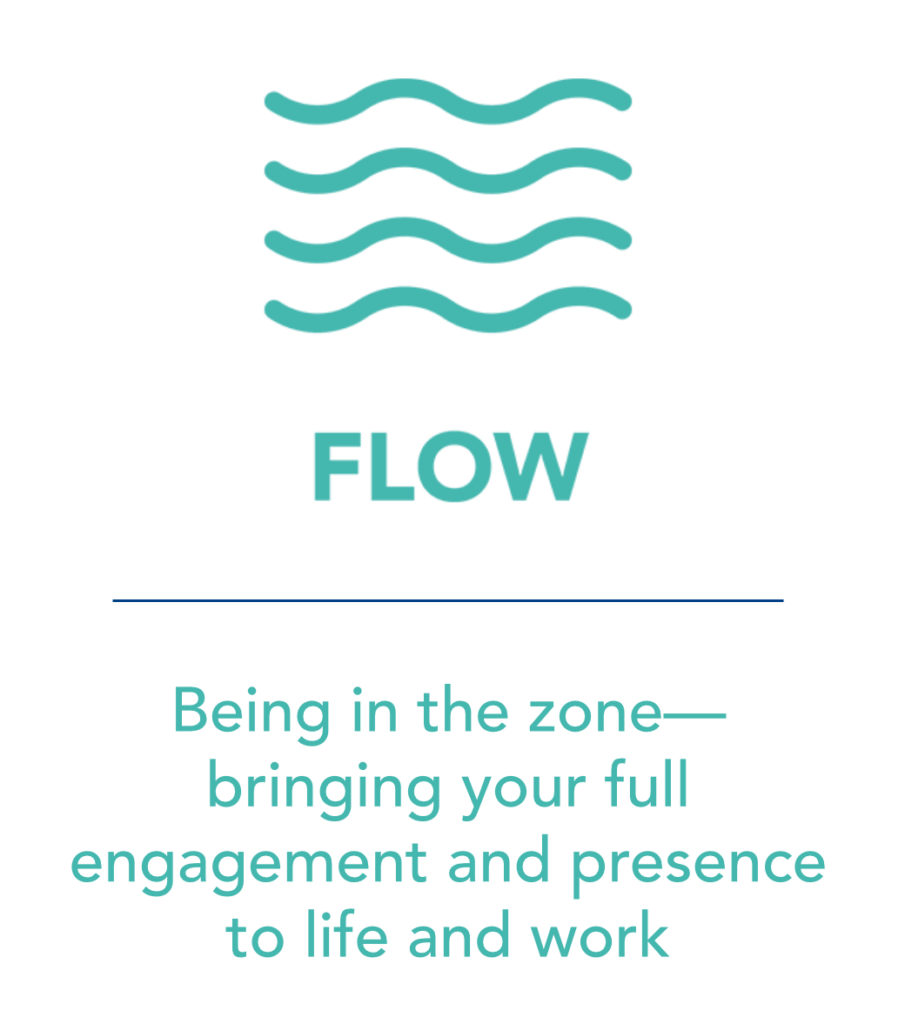How do you drive positive outcomes at work at the same time the work inspires people to grow and thrive?
In Be Well Lead Well Pulse® part of the answer is captured in a dimension we call FLOW.

FLOW is a common human experience regardless of gender, geography, age, or industry. It is about being in the zone, those times when you bring your full presence to life and work. You feel the effortlessness of FLOW through a hobby, sport, music, gardening, or any other activity (even washing dishes!) in which your concentration—and your whole being—is totally absorbed. In these moments, your “self” disappears. (So do outer distractions and inner obstacles that often get in your way.) Your senses are heightened. Time distorts, speeding up or slowing down. As you fully engage in the activity, you are intrinsically rewarded with energy, enjoyment, deep connection, and a rich experience of how life unfolds with ease.
At Wisdom Works, we believe work is a prime opportunity for people to find FLOW. When this happens, work becomes not only an avenue for being productive and accomplishing results, but also for elevating the wellbeing and growth of individuals, teams, and organizations.
The FLOW dimension of Be Well Lead Well Pulse® measures three of 19 vital psychometrics of holistic wellbeing and stress resilience:
- Engagement at Work: The extent to which people get immersed in their work, feel happy and inspired by work, and experience inherent satisfaction and pleasure in the work itself.
- Self-Esteem at Work: The extent to which people perceive themselves as important, meaningful, worthwhile, effectiveness, and valuable to the organization—an internal sense that they make a positive difference at work.
- Mindfulness: The extent to which people pay attention to the present moment without evaluating it as good or bad and act with awareness rather than reactivity.
Try these practices to experience FLOW
FLOW doesn’t have to be elusive. Nor does it necessarily mean overhauling your life. However, it does entail working with, instead of against, the innate human rhythms that can empower you and your team to thrive. These three (out of many!) practices can help you design your workday for experiences of FLOW.
1. RESPECT CIRCADIAN TIME.
As neuroscientist Andrew Huberman says, none of us escape this cycle. Every cell in our body has a 24-hour timer regulating our sleep-wake phases, gene expression, and body processes. Overriding this circadian rhythm links to diminished physical and mental performance, as well as greater reactivity, depression, seasonal affective disorder, diabetes, and other chronic health conditions. Align to your internal circadian clock with these three actions: View 10-30 minutes of bright light or sunlight first thing in the morning, limiting light toward the end of the day. Engage in physical activity throughout your schedule. Take in healthy FUEL, such as good nutrition and hydration, at regular time windows. (Hunger, thirst, and poor-quality FUEL will restrict your possibilities for FLOW.) Check out this timeline to support you.
2. OPTIMIZE ULTRADIAN TIME.
While you respect the 24-hour circadian cycle, honor the smaller ultradian rhythms, too. For instance, our basic rest-activity cycle involves a rise then fall in our alertness approximately every 90 minutes. How can you work with this natural pattern to foster FLOW? Organize your day into chunks of focused work punctuated by rest periods. Pause regularly to enjoy one of these conscious breaths. Plus, integrate these additional practices into your routine. This is not only about energizing high performance for you and your team, but also making high performance sustainable.
3. BUILD YOUR MINDFULNESS MUSCLE.
Mindfulness is a bridge to FLOW. Incorporating mindfulness into the day’s activities and team’s work builds your individual and collective muscles for self-observation and positive change. As a past mentor of mine says, “When you are able to see differently, you are able to intervene differently.” Explore the concepts and practices in Part 1 and Part 2 of this article to apply mindfulness as a leadership and team strength—and a gateway to FLOW at work.





